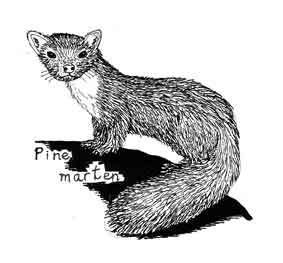|
|
|
| Colney Nature Watch |
| A series of articles on the wild life in London Colney |
| Pine Martin |

In the old days, pine marten
were pursued and slaughtered by farmers and gamekeepers. But now we know
more about pine martens' eating habits they are now largely left alone,
and with the spread of commercial forestry they are moving from their onetime
strongholds in Scotland and Wales. The pine marten is a little smaller than
the domestic cat, and considerably slimmer. It is dark brown with a creamy
bib. It is unusual amongst mammals in having hair growing under its feet:
this is because in their natural haunt, cold upland areas - they have to
conserve all their body heat. Pine marten are very agile, and can follow
squirrels up trees, which they catch and eat. By choice, pine marten most
like eating small mammals and birds, but they also enjoy fruit, nuts and
insects. Pine Marten have few natural enemies: although I suspect a buzzard
or red kite would happily dispatch one if they met. Pine marten like living
in forests - not necessarily pine - as long as there are sunny glades and
rides. They mainly build their dens in stony outcrops or the roots of trees,
but they have been found making a nest in bird boxes and hollow trees, Pine
marten are mainly carnivorous - you'd never expect them to have a dense
population. They get together in July, when they mate, but although intercourse
has taken place, the actual implantation is delayed till January when pregnancy
begins. The mother gives birth to three or so cubs in April, and it is a
further six weeks before their eyes open. The cubs are reliant on their
parents for a further six months, and when the cubs first leave home many
die. This is because they are inexperienced in hunting: but if they survive
the first year, they will probably live another four years. People who have
kept pine marten as pets report them living up to ten years, but this is
because of regular food, veterinary care and protection from bad weather.
When gamekeepers and farmers were persecuting pine marten, scientists did
a lot of research to discover what they actually ate, and farmers realised
their lambs and hens weren't at risk and gamekeepers learnt that pine marten
were not interested in pheasant fish or grouse. There are several other
species of marten living in Europe. In Germany, France Italy and Austria
there is the beech marten - which for reasons IÕll shortly divulge, happily
does not live here! Beech marten have a similar diet to pine marten, but
are rather bolder, and happily set up home on housing estates. They forage
for food in and around houses, and for some strange reason have a great
love of electric wire insulation. No doubt, some beech marten end up getting
a fatal shock, but they have also been the cause of domestic fires. Again,
beech marten happily nibble the wires in car electrics. It would be nice
if one day we saw pine marten living on the outskirts of our village - lets
hope some idiot doesn't import a pregnant female beech marten! |
|
|




